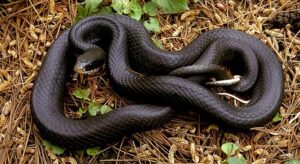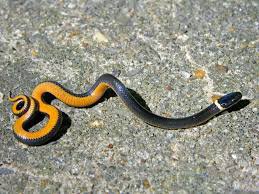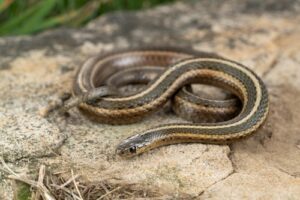Discovering holes in your yard can be unnerving, as it is often difficult to tell what created it, and if it is still occupied or not. Snakes, for example, have a tendency to move into holes previously dug by rodents or other animals. Being able to identify these holes and determine if they are occupied by snakes is a small but important way to ensure the safety of your family and pets. In this guide, we will delve into the characteristics of snake holes and provide you with actionable advice to handle them effectively.
What Does a Snake Hole Look Like?
Snakes don’t create their own holes. Rather, they take over the former holes of rodents, turtles, and frogs, usually after eating them. It is for this reason that it can be difficult to tell if a hole is occupied by a snake or by some other animal. Typically, snakes prefer holes that range from as small as half an inch to several inches in diameter and are usually narrower at the entrance, widening as they go deeper into the ground. The shape may be circular or slightly oval.
Look for fresh snake tracks near the entrance to identify recent snake activity around a hole. These tracks often appear as wavy lines in the soil. Another sign is the presence of shed snake skins nearby, as snakes shed their skin periodically, often close to their burrows. Disturbed or displaced soil around the hole’s entrance can indicate recent snake activity.
What Snakes Are in Florida Yards?
Noticing potential snake holes in your backyard can naturally lead to questions about the type of snakes you might be dealing with. Fortunately, while Florida is home to no less than forty-six snake species, only six of them are venomous, and it is rare to encounter most venomous snakes in developed areas. With that said, here are a few snake species that are commonly found in residential areas:


Found all throughout the southeastern united states, the southern black racer is a black snake, growing 4-5 feet long, that relies on its swiftness and agility to catch prey. Totally harmless to humans, southern black racers can commonly be found sunning themselves on lawns, shrubbery, walkways, and fences.
 Along with the Black Racer, the Southern Ring-Necked snake is one of the most common snakes found in residential areas in Florida. Their name is derived from the yellow ring that circles their neck area. These snakes are harmless and prefer to spend their time under logs or rocks, lunching on earthworms, slugs, salamanders, and lizards.
Along with the Black Racer, the Southern Ring-Necked snake is one of the most common snakes found in residential areas in Florida. Their name is derived from the yellow ring that circles their neck area. These snakes are harmless and prefer to spend their time under logs or rocks, lunching on earthworms, slugs, salamanders, and lizards.
 Rat snakes, also known as corn snakes, have a beautiful pattern of reddish-orange blotches outlined in black. Rat snakes are excellent climbers, and are frequently found scaling shrubs or fences in residential areas. The good news is, rat snakes are harmless and non-venomous, but may be quite defensive and emit a foul musk if cornered.
Rat snakes, also known as corn snakes, have a beautiful pattern of reddish-orange blotches outlined in black. Rat snakes are excellent climbers, and are frequently found scaling shrubs or fences in residential areas. The good news is, rat snakes are harmless and non-venomous, but may be quite defensive and emit a foul musk if cornered.
 Occasionally misidentified as pygmy rattlesnakes due to the splotched pattern of their skin, garter snakes are non-venomous snakes commonly found in residential areas. They are often found among landscape plants near houses, or along the edges of ditches or ponds.
Occasionally misidentified as pygmy rattlesnakes due to the splotched pattern of their skin, garter snakes are non-venomous snakes commonly found in residential areas. They are often found among landscape plants near houses, or along the edges of ditches or ponds.
Not only is the pygmy rattlesnake the smallest venomous snake in Florida, it is also the one that humans are most likely to encounter. Pygmy rattlesnakes measure around a foot in length and are gray with irregular dark blotches down the back, with a broken reddish-brown line between the blotches. They feed primarily on frogs and mice. These snakes do have rattles, but they are small and nearly inaudible, creating an insectile buzzing sound. Despite their diminutive size, pygmy rattlesnakes are quite defensive, and may strike if approached.
Remember, most snakes prefer to avoid human interaction and pose little threat to humans. If you’re unsure about the type of snakes in your backyard or feel trepidation about dealing with snakes directly, contact a professional wildlife removal service like Trutech, whose team of experts can help identify the snake species and provide safe and effective solutions.
What Snakes Are in Florida Yards?
If you’ve noticed holes in your yard and suspect they might be snake holes, it’s important to differentiate them from other animal burrows. Snakes prefer burrowing in loose soil or in areas with ample ground cover, such as tall grass, shrubs, or under rocks or debris. While holes created by moles or gophers often have a visible mound of soil around them, by the time snakes take over the hole, the mound has usually gone away.
How to Determine if Snake Hole is Occupied
- Place line layer of sand or flour to check for fresh tracks
- Carefully place twig or leaf of entrance
Should I Cover a Snake Hole in My Yard?
Finding snake holes in your yard can be a scary situation. You might feel tempted to cover the hole up to get rid of snakes. We do not recommend this.
- Preventive measures to discourage snakes from returning to your yard is much more effective. Keep your lawn well-maintained by regularly mowing the grass and trimming bushes.
- Remove any debris, such as piles of leaves or wood, as these can provide hiding spots for snakes.
- Consider installing a snake-proof fence around your property to further deter snakes from entering
Remember, snakes come to your yard for shelter and food. If you have seen the same snake in your yard consistently for a a few days, that can be a clear indication of a rodent infestation. When predators are present, rodents will find more secure places which includes your home.
Snake Holes on Your House
Unlike other nuisance wildlife, snakes cannot create their own animal entry point. They are skilled at finding their way into homes, often through small openings that may go unnoticed. Understanding how snakes get inside your house and knowing the typical places for snake entry holes can help you take preventative measures to keep these slithering critters out.
Common Snake Entry Points:
- Cracks and gaps: Snakes can squeeze through tiny cracks and gaps in the foundation, walls, or windows of your house. Even the smallest openings can be an invitation for these reptiles.
- Doors and windows: If doors and windows are not properly sealed or have gaps in their frames, snakes can easily slither their way inside.
- Vents and pipes: Snakes are excellent climbers and can make their way into your home through vents or pipes that are not adequately covered or protected.
- Foundation: Snakes can enter through gaps in the foundation, especially near utility pipes or areas where the foundation has shifted or cracked.
- Exterior walls: Look for cracks or holes in the exterior walls of your house, particularly around utility openings or damaged siding.
Where Do Snakes Hide in Your House?
Snakes look for a place where they feel protected, which is why it can be difficult to find a snake once one has entered your home. Snakes will hide behind the refrigerator, under the oven, under your bed, or inside cabinets.
- Attic: Snakes can access your attic through gaps in the eaves, vents, or damaged roof shingles.
- Crawl spaces: Inspect crawl spaces for any openings or gaps that snakes could use as entry points.
By identifying potential snake entry holes and sealing them off, you can minimize the risk of snakes finding their way inside your home. If you suspect you already have snakes in your house, it’s best to contact a professional wildlife removal service like Trutech to safely and effectively handle the situation.
Remember, if you’re uncertain or uncomfortable dealing with snake holes on your own, it’s always best to seek professional wildlife control.

Jacksonville Animal Control
Over 90,000 households served in Jacksonville Schedule a Free Inspection Some Geographic Restrictions (904) 441-5182 About Us Wildlife We Remove in Jacksonville, FL The First

Davenport Wildlife Removal
Schedule a Free Inspection Some Geographic Restrictions (863) 225-8409 Unwelcomed animals in your home will make their presence known. Animal noises are the most obvious

Wildlife Pest Control in Amelia Island
Schedule a Free Inspection Some Geographic Restrictions 904-977-6278 Wildlife We Remove in Amelia Island, FL Amelia Island is Florida’s northernmost barrier island and is unique

First Coast Wildlife Removal
Schedule a Free Inspection Some Geographic Restrictions 904-906-4292 Wildlife We Remove in Northeast Florida The First Coast has a rich history and some of the

Port Charlotte Wildlife Removal
Schedule a Free Inspection Some Geographic Restrictions 239-558-1858 Wildlife We Remove in Port Charlotte, FL Port Charlotte is the heart of Charlotte County, as it’s

Panama City Wildlife Removal
Schedule a Free Inspection Some Geographic Restrictions 850-757-9430 Common Nuisance Wildlife Driving along the water on U.S. Route 98 is one of the best ways


